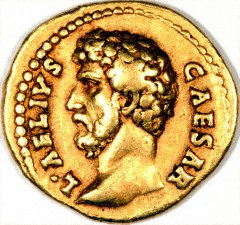Roman Empire More Equal than the United States
In The Size of the Economy and the Distribution of Income in the Roman Empire, a careful paper published in the Journal of Roman Studies in 2009, Walter Scheidel and Steven Friesen estimate the size and distribution of the Roman economy at its demographic peak around the middle of the 2nd century c.e.
We conclude that in the Roman Empire as a whole, a ‘middling’ sector of somewhere around 6 to 12 per cent
of the population, defined by a real income of between 2.4 and 10 times ‘bare bones’
subsistence or 1 to 4 times ‘respectable’ consumption levels, would have occupied a fairly
narrow middle ground between an élite segment of perhaps 1.5 per cent of the population and a vast majority close to subsistence level of around 90 per cent. In this system, some 1.5 per cent of households controlled 15 to 25 per cent of total income, while close to
10 per cent took in another 15 to 25 per cent, leaving not much more than half of all income for all remaining households.
Thus, in Rome the top 1.5% controlled 15-25% of income while in the United States around 2007 the top 1% controlled 23.5% of income thus suggesting slightly more inequality in the United States. Scheidel and Friesen calculate a Roman Empire gini coefficient of .42-.44 again perhaps slightly less than the U.S. coefficient of around .4-.45 depending on source.
Interestingly, the Roman State did not manage to collect that much:
Given a GDP of somewhere
around HS17–19bn, annual state expenditure of approximately HS900m would have
represented an effective tax rate of approximately 5 per cent of GDP, which is the same as
for France in 1700. This finding confirms Hopkins’s claim that the imperial government
did not capture more than 5 to 7 per cent of GDP and that Roman taxes were fairly low.
The overall public sector share of GDP was somewhat larger depending on the scale of
municipal spending, while the overall nominal tax rate had to be higher still in order to
accommodate taxpayer non-compliance, tax amnesties, and rent-seeking behaviour by
tax-collectors and other intermediaries. Moreover, we must not forget that Italy’s immunity from output and poll taxes required the public sector share in the provinces to exceed
the empire-wide average. These various adjustments allow us to reconcile our GDP estimate with reported nominal taxes of around 10 per cent of farm output on private land
reported in Roman Egypt and somewhat higher rates in less developed regions where
enforcement may have been more difficult.
(Thus, despite the aqueducts Rome may not have done that much for the people after all.)
Hat tip to Tim De Chant at Per Square Mile who has further discussion.
